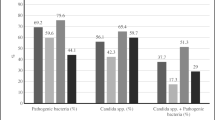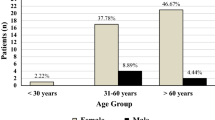Abstract
A total of 43 patients, 11 males and 32 females, with paronychia of the fingernails were examined for the presence ofCandida spp. The yeast species isolated were identified using standard laboratory methods, including germ-tube production, morphology on rice agar with Tween 80, and mainly fermentation and assimilation of saccharides. In the male group, twoCandida species were detected:C. albicans as the dominant species in 9 patients andC. parapsilosis in 2 cases. Similarly,C. albicans was the prevalent species also in females (n = 17); otherCandida species detected wereC. parapsilosis (n = 7),C. tropicalis (5) andC. krusei (3). In addition to the genusCandida, the following anaerobic and aerobic microorganisms were isolated from patients of both groups:Fusobacterium spp.,Bacteroides spp.,Staphylococcus aureus, α-hemolytic streptococci, group A β-hemolytic streptococci,Klebsiella pneumoniae, Neisseria spp. andPseudomonas aeruginosa.
Similar content being viewed by others
References
Brook I.: Aerobic and anaerobic microbiology of paronychia.Ann.Emerg.Med.19, 994–996 (1990).
Brook I.: Paronychia: a mixed infection.J.Hand Surg.Brit.18, 358–359 (1993).
Daniel C.R., Elewski B.E., Daniel C.M., Sullivan S., Ellis G.: Chronic paronychia and onycholysis: a thirteen-year experience.Cutis58, 397–401 (1996).
Daniel C.R., Elewski B.E.:Candida as a nail pathogen in healthy patients.J.Miss.State Med.Assoc.36, 379–381 (1995).
Dorko E., Pilipčinec E., Tkáčiková L’.: Candidal urinary tract infections caused by non-albicans Candida species.Folia Microbiol.47, 182–184 (2002a).
Dorko E., Jautova J., Tkáčiková L’., Wantrubová A.: The frequency ofCandida species in onychomycosis.Folia Microbiol.47, 727–731 (2002b).
Dorko E., Virágová S., Pilipčinec E., Tkáčiková L’.:Candida — agent of the diaper dermatitis?Folia Microbiol.48, 385–388 (2003).
Faergemann J.: The role of yeasts in onychomycosis.Mycoses39, 223–224 (1996).
Ganor S., Pumpianski R.: ChronicCandida albicans paronychia in adult Israeli women.Brit.J.Dermatol.90, 77–83 (1974).
Haneke E.: Fungal infections of the nail.Semin.Dermatol.10, 41–53 (1991).
Hay R.J.: The management of superficial candidiasis.J.Am.Acad.Dermatol.40, 35–42 (1999).
Hermann P., Forgács K., Gal E., Lenkey B., Nagy G., Rozgonyi F.: Effects of alkali metal ions on some virulence traits ofCandida albicans.Folia Microbiol.48, 173–176 (2003).
Hochmann L.G.: Paronychia: more than just an abscess.Internat.J.Dermatol.34, 385–386 (1995).
Jautová J., Virágová S., Ondrašovič M., Holoda E.: Incidence ofCandida species isolated from human skin and nails: a survey.Folia Microbiol.46, 333–337 (2001).
Lazurová I.: Diabetes mellitus and endocrinopathies. (In Slovak)Cartridge4, 49–71 (2000).
Lazúrová I., Schroner Z., Trejbal D.: Diabetes mellitus and thyreopaties. (In Slovak)Slov.Lekár7–8, 283–285 (2000).
Montemarano A.D., Benson P.M., James W.D., Crowe M.A.: Acute paronychia apparently caused byCandida albicans in a healthy female.Arch.Dermatol.129, 786–787 (1993).
Mucke R., Kaben U., Libera T., Knauerhase H., Ziegler P.G., Hamann D., Strietzel M.: Fluconazole prophylaxis in patients with head and neck tumors undergoing radiation and radiochemotherapy.Mycoses41, 421–423 (1998).
Roberts D.T., Evans E.G.V., Allen B.R.:Fungal Infections of the Nail. Mosby International, London 1998.
Rockwell P.G.: Acute and chronic paronychia.Am.Fam.Physician63, 1113–1116 (2001).
Russo F., Collantes C., Guerrero J.: Severe paronychia due to zidovudine-induced neutropenia in a neonate.J.Am.Acad.Dermatol.40, 322–324 (1999).
Tasic S., Stojanovic S., Poljacki M.: Etiopathogenesis, clinical picture and diagnosis of onychomycoses. (In Serbo-Croatian Roman)Med.Pregl.54, 45–51 (2001).
Tomšíková A.: Causative agents of nosocomial mycoses.Folia Microbiol.47, 105–112 (2002).
Yates Y.J., Concannon M.J.: Fungal infections of the perionychium.Hand Clin.18, 631–646 (2002).
Author information
Authors and Affiliations
Corresponding author
Rights and permissions
About this article
Cite this article
Dorko, E., Jautová, J., Pilipčinec, E. et al. Occurrence ofCandida strains in cases of paronychia. Folia Microbiol 49, 591–595 (2004). https://doi.org/10.1007/BF02931539
Received:
Revised:
Issue Date:
DOI: https://doi.org/10.1007/BF02931539




